PO 39. Understand the three stages of soil erosion and their relation to soil properties.
|
The three stages of soil erosion are: dislodgement, transportation, andsedimentation. Silt is usually preferentially dislodged and transported because clay particles tend to be flocculated and combined in aggregates which increase their mass, and sand particles are larger and heavy.
Aggregation of course also affects this process: a well-aggregated soil is less sensitive to dislodgement and transportation than a poorly aggregated soil. Soil cover dramatically affects dislodgement by protecting the soil from raindrop impact.
Soil cover also reduces transportation by providing physical barriers and opportunities for ponding and velocity reduction. Infiltration affects transportation. Hence a soil with high infiltration will have less transportation.
Sedimentation occurs when the velocity and carrying capacity of runoff decreases. This may happen if soils change in slope or infiltration capacity.
|
|
.jpg)
Soil erosion on a hillside
image source: http://instruct1.cit.cornell.edu/Courses/css412/mod4/ext_m4_pg7.htm
|
PO 40. Understand the main agronomic and environmental consequences of soil erosion and sedimentation.
|
Agronomic:
- Organic-matter rich surface soil is removed.
- Nitrogen, phosphorus, potassium, and other nutrients in mineral and organic form are lost from the field.
- Herbicides and other pesticides attached to soil particles will be removed from the field.
- Since silt particles are preferentially removed in erosion, the soil tends to either become more clayey or more sandy.
- Soil depth is reduced, leading to reduced root volume and increased moisture stress.
- Rill and gully formation will compromise field work.
- Deposition can cause newly planted crops to be lost.
|

Runoff from farm fields reaches a sediment-laden stream
Photo courtesy of NRCS
http://photogallery.nrcs.usda.gov
|
|
|
Environmental:
- Increased need for channel dredging.
- Adverse impacts on the recovery of underwater grass beds because the sediment reduces the amount of light reaching plants.
- Benthic (bottom-dwelling) organisms suffer increased mortality and reduced reproduction.
- Fish may be affected as increased sediment affects their feeding, clogs gill tissues, and smothers eggs.
- Siltation can alter the habitat of aquatic organisms.
- Increased turbidity may change the abundance of plankton, a prey which is important for larval and juvenile fish.
- Phosphorus is carried with the sediment, contributing to eutrophication.
|
|
|
PO 41. Understand the different types of soil erosion
|
There are four types of water erosion:
- Inter-rill erosion: the movement of soil by rainsplash and its transport by thin surface flow whose erosive capacity is increased by turbulence generated by raindrop impact. The term sheet erosion is frequently used instead of inter-rill erosion, but it omits the concept of rain-splash and conveys the erroneous concept that runoff commonly occurs as a uniform sheet.
- Rill erosion: erosion by concentrated flow in small rivulets.
- Gully erosion
- Streambank erosion
|
|

Rill erosion
Photo courtesy of NRCS
http://photogallery.nrcs.usda.gov
|
PO 41. Understand the different types of soil erosion
|
There are four types of water erosion:
- Inter-rill erosion
- Rill erosion
- Gully erosion: erosion by runoff scouring large channels (deeper than 1 foot).
- Streambank erosion: erosion by rivers or streams cutting into banks.
|
|
|
 Gully erosion Gully erosion
Photo courtesy of NRCS
http://photogallery.nrcs.usda.gov
|
 Streambank erosion Streambank erosion
Photo courtesy of NRCS
http://photogallery.nrcs.usda.gov
|
PO 42. Understand how soil types differ in soil erodibility.
|
Soil texture, organic matter, and soil structure all affect erodibility. Silt particles are most easily removed in erosion, because sand particles are big, while clay particles are typically better aggregated than silt particles in macro-aggregates. Greater organic matter causes soils to become less erodible. Improved soil aggregate stability causes soils to be less erodible.
|
PO 43. Understand how climatic factors affect soil erosion.
|
Rainfall quantity and intensity are important. Greater rainfall amounts per year increase the potential for erosion, but the intensity of rainfall is more important. Gentle, drizzling rain from frontal storms is not highly erosive, whereas convectional storms in summer or fall produce downpours with large droplet size which can cause severe erosion. Hurricanes also typically produce high intensity rainfall events.
|
|

Erosion and deposition of sediment due to heavy rains
Photo courtesy of NRCS
http://photogallery.nrcs.usda.gov
|
PO 44. Know how the topographic factors of slope and slope length affect soil erosion.
|
Erosion increases with increasing slope and slope length.
|
|

Steep slopes are more likely to become eroded, as evidenced by these hillsides.
The lighter areas have lost topsoil to erosion.
Photo courtesy of NRCS
http://photogallery.nrcs.usda.gov
|
PO 45. Explain the Revised Universal Loss Equation (RUSLE).
|
The Natural Resources Conservation Service (NRCS) uses the Revised Universal Soil Loss Equation (RUSLE) to calculate soil loss by erosion as a function of 5 factors:
A = R × K × LS × C × P
Where:
A = annual soil loss (tons/acre/yr)
R = erosivity of rainfall
K = erodibility of the soil
LS = slope length/steepness
C = cropping and management factors
P = erosion control practices
Go to: www.iwr.msu.edu/rusle/ for an example of how RUSLE works
|
PO 46. Understand how agronomic management practices can reduce erosion.
- Tillage and crop residue management
- Crop rotations
- Cover cropping
Tillage and crop residue management
Clean tillage leaves the soil unprotected by burying all crop residue. Leaving more residue at the surface will protect the soil from erosion. All tillage disturbs and loosens soil and this make the soil more sensitive to erosion.
Crop rotations
Crop rotations can help control erosion by rotating perennials with annuals because the soil will not be tilled during the growth of the perennial. Rotations of crops with wide row spacing such as corn with crops with narrow row spacing such as small grains also helps combat erosion because the latter protect the soil better. If crops are planted in strips, the soil that is eroded from a bare strip will be caught in the strip with living vegetation below it.
Cover cropping
Keeping the soil covered in the fall and winter protects it from erosion. The mulch left by the cover crop can protect the soil from erosion (if not plowed under). The cover crops help improve soil aggregate stability.
|
PO 47. Understand the basic approaches to structural soil conservation practices.
- Filter strips
- Grassed waterways
- Diversions
- Ponds
- Terraces
- Drop structures
Filter Strips
Filter strips are strips or areas of permanent vegetation used to filter sediment, organic materials, nutrients, pesticides, and other contaminants from runoff.
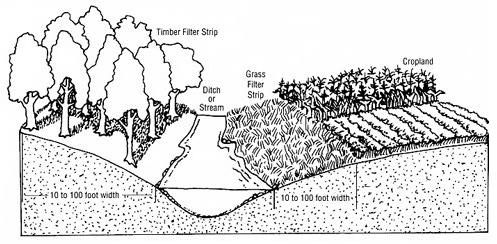
image source: http://ohioline.osu.edu/aex-fact/images/467_1.jpg
|
|
Grassed waterways
Grassed waterways are natural or constructed swales of permanent vegetation where water usually concentrates as it runs off a field.
|
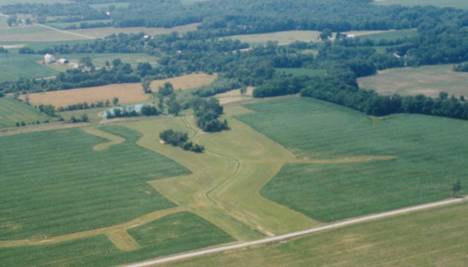
Grassed waterway
image source: http://www.oh.nrcs.usda.gov/programs/Lake_Erie_Buffer/images/waterway.JPG
|
PO 47. Understand the basic approaches to structural soil conservation practices.
- Filter strips
- Grassed waterways
- Diversions
- Ponds
- Terraces
- Drop structures
|
Diversions
Diversions are cross-slope channels used to intercept surface runoff and divert it to a safe or convenient discharge point. They are usually placed above the area to be protected and are permanently vegetated with grass. They are often used on steeper slopes where a terrace would be too expensive or difficult to build, maintain, or farm. They can also be used to protect barnyards or farmsteads from runoff.
|
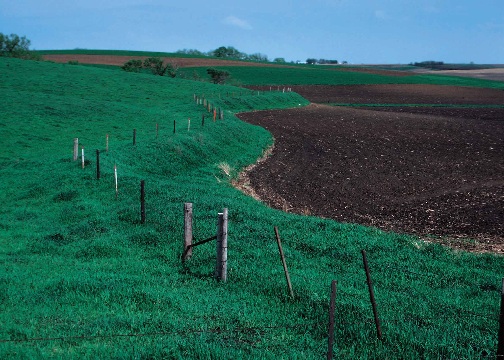
Diversion terrace
Photo courtesy of NRCS
http://photogallery.nrcs.usda.gov
|
|
Ponds
Ponds can act as sedimentation basins. Surface (open tile) inlets allow movement of surface runoff water into underground tile drains and safely direct discharge into surface waters. WASCOBs (water and sediment control basins) are short earthen dams built across a drainage way that trap sediment and water.
|

Conservation pond
Photo courtesy of NRCS
http://photogallery.nrcs.usda.gov
|
PO 47. Understand the basic approaches to structural soil conservation practices.
- Filter strips
- Grassed waterways
- Diversions
- Ponds
- Terraces
- Drop structures
|
Terraces
Terraces are broad cross-slope channels similar to diversions, used to control erosion on cropland and built so that crops can be grown on the terrace. Storage terraces store water until it can be absorbed by the soil or released to stable outlet channels or through underground outlets. Storage terraces are usually designed to drain completely in 48 hours to avoid waterlogging within the terrace. Gradient terraces are gently sloping channels constructed almost perpendicular to the natural field waterway. Various different types (constructed shapes) of terraces include bench, broad-base, channel-slope to reduce field slope lengths, and collect runoff water and carry it to a stable outlet like a type, conservation bench, graded, level, Mangum, narrow-base, parallel, nonparallel, ridge-type, ridgeless-channel, and steep-backslope terrace.
|
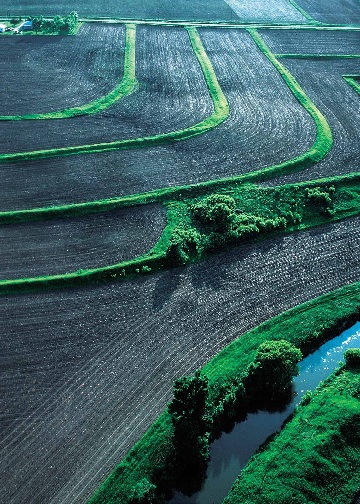
Terraces as part of soil conservation
Photo courtesy of NRCS
http://photogallery.nrcs.usda.gov
|
|
Drop structures
Drop structures are hydraulic structures for safely transferring water in a channel to a lower level channel without causing erosion. They can be vertical or slanting and are typically built with a vertical riser conduit (drop-inlet spillway) or an apron (drop spillway) with a plunge pool at the base. The plunge pool acts to dissipate flow and reduce erosion of the stream bottom.
|
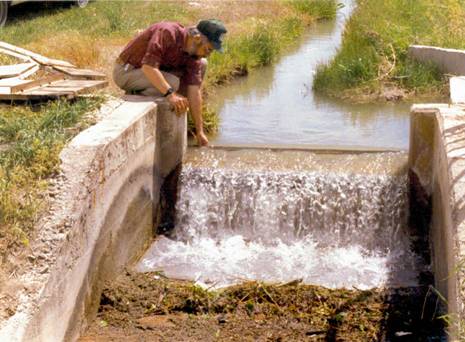
Drop structure
image source:
http://www.ars.usda.gov/SP2UserFiles/Place/53680000/
presentations/trashscreen/squarescreen1.jpg
|
PO 48. Understand the purpose of tillage
|
Tillage can be defined as any mechanical manipulation of soil. The goal of proper tillage is to provide a suitable environment for seed germination, root growth, weed control, soil-erosion control, and moisture control (John Deere, 1993).
|
PO 49. Describe the basic components and workings of tillage systems, and understand their agronomic and environmental benefits.
- Plow-till
- No-till
- Mulch-till
- Ridge-till
- Zone tillage
Distinctions are made between primary and secondary tillage.
Primary tillage is usually the deepest operation in the system, which loosens and fractures the soil to reduce soil strength, invert and cover previous crops or weeds and to bring or mix residues and fertilizers in the tilled layers. The implements for primary tillage include moldboard, chisel, and disk plows, heavy tandem, offset and one-way disks, subsoilers and heavy-duty, powered rotary tillers.
Secondary tillage is used to kill weeds, cut and cover crop residues, incorporate herbicides, and prepare a well pulverized seedbed. Secondary tillage tools include light- and medium-weight disks, field cultivators, row cultivators, rotary hoes, drags, powered and unpowered harrows or rotary tillers, rollers, ridge- or bed-forming implements, and numerous variations of those.
|
PO 49. Describe the basic components and workings of tillage systems, and understand their agronomic and environmental benefits.
- Plow-till
- No-till
- Mulch-till
- Ridge-till
- Zone tillage
|
Plow-till.
Typically consists of primary tillage with a moldboard plow, followed by one or more passes with a disk and another type of harrow. The moldboard plow is the best weed controlling tillage tool. It also thoroughly inverts the soil, incorporating and covering residue, fertilizer or manure. Thus, it reduces ammonia volatilization if performed immediately after manure or urea application, and it reduces odor nuisance. However, the plow-till system is one of the more soil degrading tillage practices because of its aggressive disturbance and reduction of mulch cover. This system uses the most fossil fuel for field operations and takes the most labor.
|
|
|
No-till.
No tillage is done, crops are planted with a no-till planter or drill, and weeds are controlled without tillage. Manures and fertilizers are applied to the soil surface or may be injected with low-disturbance injectors. If left at the surface, ammonia volatilization and odor are a concern. No-tillage systems conserve soil and build soil organic matter. They also have a beneficial effect on soil organisms. Fossil fuel use for field operations is low as well as labor needs. Odor from manure, planting issues through heavy residue, and weed control are the greatest challenges with this system. Even crop residue spread at harvest is extremely critical for success with no-tillage.
|

Soybeans growing in a no-till field
Photo courtesy of NRCS
http://photogallery.nrcs.usda.gov
|
PO 49. Describe the basic components and workings of tillage systems, and understand their agronomic and environmental benefits.
- Plow-till
- No-till
- Mulch-till
- Ridge-till
- Zone tillage
|
Mulch-till.
A type of conservation tillage which includes a form of field-wide tillage which leaves more than 30% crop residue cover after planting. Common tillage tools used with this system are chisel plows, disk harrows and field cultivators. Erosion control is much better than that obtained with moldboard plowing due to the increased mulch cover, but not as great as that obtained with no-tillage. Organic matter content is typically higher than with plow-till, but lower than with no-till. Mixing of manure and urea fertilizers is usually sufficient to reduce ammonia volatilization (if done quickly after application) and odor nuisance.
|

Mulch-tillage
Photo courtesy of NRCS
http://photogallery.nrcs.usda.gov
|
|
Ridge-till.
A tillage system in which no tillage is done from harvest until planting, except for nutrient injection. Crops are grown on preformed ridges. The ridges are usually formed in the previous crop with in-row cultivators. Ridge tillage is a way to reduce use of in-crop herbicide inputs, and it is a form of precision traffic because all traffic takes place between rows. Manure is typically not incorporated, which increases ammonia volatilization losses and odor nuisance. Organic matter content is typically similar to mulch-till systems, and erosion control is good due to the high residue cover after planting. All crops need to be planted on the same row-spacing, and equipment needs to be redesigned to run between the ridges.
|

Soybeans growing in a ridge-tillage system
Photo courtesy of NRCS
http://photogallery.nrcs.usda.gov
|
|
Zone tillage.
A system that is similar to no-tillage, except zones are formed either during planting or previous to planting. The major benefit of zone tillage over no-tillage is the faster emergence of early planted summer crops such as corn. Zone tillage takes more tractor power, and equipment costs are higher than with no-tillage. Erosion control is excellent.
(Go to: ftp://ftp-fc.sc.egov.usda.gov/IA/intranet/Tillage.pdf to see tillage equipment)
|
|
PO 50. Understand the adaptability of tillage systems to common soil types in the Northeast based on the following considerations:
- Texture
- Drainage class
- Climate
Texture
Light-textured soils benefit from heavy crop residue cover because of its moisture savings. These soils dry out quickly and are well-drained. No-tillage is therefore the system of choice on these soils.
Heavy clay soils dry out slowly in the spring and may cause corn to emerge slowly in no-tillage with heavy crop residue cover. Mulch-till, ridge-till or zone tillage may be the optimum choice, although some attachments on the planter may achieve satisfactory results in no-tillage as well. Slope and stoniness are also factors that determine which system is optimal.
On steeply sloping soils erosion control is more acute and greater residue cover more important. Stony soils are most suitable to no-tillage crop production.
Drainage class
In general, the better drained a soil is, the more suitable it is to high-residue or no-tillage farming. In well-drained soils moisture conservation is a benefit, and soil warming is generally not a big problem. In poorly drained soils, however, excessive moisture does not evaporate under a mulch layer, and early warming of the soil may be problematic, especially for corn production and other early planted crops, but not for fall-seeded crops or crops planted later than corn.
High residue systems are more challenging on poorly drained soils, but can be implemented successfully with some planting equipment modifications and proper planning of crop rotations. High residue systems on poorly drained soils may help facilitate non soil disturbing types of trafficability.
Climate
The major determinant of variations in climate in the Northeast is temperature and the onset of the seasons. High residue and no-tillage systems tend to have slower soil drying and warming in spring and are therefore more challenging in the northern parts of the Northeast.
|
PO 51. Understand the adaptability of tillage systems to various cropping systems.
- Livestock-based systems
- Conventional cash grain systems
- Low-input and organic cash grain systems
- Horticultural and vegetable production systems
Livestock-based systems
- Residue Return: Care needs to be taken to return organic residues (manure) to the soil, grow cover crops in fallow periods, and minimize further organic losses through intensive tillage.
- Crop Diversity: Many crops can be grown for forage to increase crop diversity. High crop diversity can be used to great advantage in permanent no-tillage systems. Since different crops are planted at different row spacings, ridge tillage is not a favored tillage system.
- Soil Compaction: Manure application and timely harvest during fall, winter and spring when soils are still wet can pose a significant compaction risk. If compaction is caused, surface or deep tillage may be required to alleviate its effects.
- Soil Erosion: It is important to maintain living vegetation the land to protect the soil from erosion and compaction, and to take up nutrients that may be released when organic matter from manure applications is decomposing. Cover crops can be established with no-tillage practices.
- Soil Warming: Soil warming may be a concern with no-till systems when corn is planted into a high residue cover that remains from the previous corn grain harvest. Zone tillage may be a practical alternative.
- Weed Control: Plow tillage is the best weed control option besides herbicides to control perennials and many annuals.
- Nutrient Management: If nitrogen conservation is a major goal, injection may be the best option. Alternatively, plow or mulch tillage may achieve the same goal, but is often challenging immediately after manure application.
Conventional Cash Grain systems
- Residue Return: Most residue is left in the field, which helps with organic matter conservation and erosion control. The return of crop residues to soil can compensate for some of the organic matter losses due to tillage.
- Crop Diversity: Crop diversity may be low and can pose a problem for soil quality and successful no tillage. Mulch tillage is preferred over plow tillage to limit soil impacts. Ridge tillage is an option in crops planted at the same row spacing. Zone tillage can be used for corn if early soil warming is a concern.
- Soil Compaction: Large grain carts with high axle loads pose a subsoil compaction threat. Grain trucks with road tires should be kept out of the fields. Continuous no-tillage may be impossible if ruts are created in much of the field.
- Soil Erosion: Because mulch is left in field, no-tillage, zone tillage or ridge tillage are used. Mulch tillage may not be possible after soybeans or small grains harvested for grain because residue cover will be reduce to less than 30%.
- Weed Control: Plow tillage may be required to eliminate severe weed problems.
- Nutrient management: Anhydrous ammonia needs to be injected with low disturbance knives, and secondary tillage may be required prior to planting.
|
PO 51. Understand the adaptability of tillage systems to various cropping systems.
- Livestock-based systems
- Conventional cash grain systems
- Low-input and organic cash grain systems
- Horticultural and vegetable production systems
|
Low-input and Organic Cash Grain systems
- Residue Return: Similar to B above.
- Crop Diversity: Permanent no-tillage is possible in low-input systems with high crop diversity, but not on organic grain farms due to weed control problems. Ridge tillage is not an option.
- Soil Compaction: These operations may be small and therefore the threat of compaction may be limited, in which case no-tillage is an excellent option. In organic systems, farmers may attempt to plow as shallow as possible to reduce tillage intensity.
- Soil Erosion: A significant threat if plow tillage is used. The effects of plow tillage need to be compensated by return of crop residues, cover crops, composts and manure additions to maintain soil quality.
- Soil Warming: Not usually a major issue on these farms because crops are typically not planted as early.
- Weed Control: Plow tillage is the best weed control around, but may be alternated with less intensive tillage such as mulch tillage or occasional no-tillage.
- Nutrient Management: If compost is applied, ammonia volatilization is not a concern and no incorporation is required.
Horticultural and Vegetable Production systems
- Residue Return: These cropping systems often include low residue crops and sometimes the whole plant is removed. Soil degradation is a significant concern that needs to be addressed by reducing or eliminating tillage.
- Crop Diversity: Cropping diversity is often high to manage plant diseases. Therefore, mulch tillage would be recommended. To help with soil improvement it is recommended to plant cover crops and to rotate with field and forage crops that are grown without tillage and return large quantities of crop residue to the soil.
- Soil Compaction: Soil compaction is a very serious threat on these farms. It may be necessary to do deep tillage to alleviate subsoil compaction or to do shallow tillage if surface compaction is prevalent.
- Soil Erosion: Wind erosion may be a concern on peat soils used for vegetable production. The solution is wind breaks and/or crop residue. Whatever can be done to reduce tillage intensity will be beneficial to improve soil quality.
- Soil Warming: Mulch cover keeps soils cool. Zone tillage or clean tillage should be considered.
- Weed Control: It is important to reduce the production of viable weed seeds and to deplete the weed seed bank. It is also important to prevent perennials from getting a foothold in continuous no-tillage. In practice, no-till may be practiced for a few years, but often needs to be followed by inversion tillage (plow till) to control weeds.
- Nutrient Management: Tillage is not a major concern for nutrient management in vegetables, except to reduce volatilization when urea is used.
|
PO 52. Understand the relation between tillage practices and:
- Residue cover
- Soil roughness
- Soil quality
- Residue fragility and persistence
Residue cover
Almost every tillage pass reduces residue cover. It is possible to estimate the effect of a tillage system on residue cover based on the percent cover after harvest, overwinter residue decomposition, and estimates of percent cover remaining after different tillage operations. Tables have been published in Midwest Plan Service – publication 45 (Conservation Tillage Systems and Management, 2nd Ed. , 2000), chapter 7).
Soil roughness
The soil surface can be smoothened by soil tillage. However, subsequent traffic creates more soil roughness after tillage, and the danger of rut formation is greater on a previously tilled soil than a long-term no-tillage soil. Ridge tillage leaves the soil in ridges.
Soil quality
Soil tillage degrades soil quality because of its negative effects on soil structure.
Residue fragility and persistence
Fragile and non-fragile residues are terms used to distinguish the different decomposition rates of crop residues. Fragile residue is from crops such as soybeans, canola, dry beans, and potatoes. Non-fragile residue is from crops such as corn, alfalfa, and small grains. The reduction in residue cover due to tillage is much greater in fragile residue than in non-fragile residue, and the persistence of fragile residue is less than that of non-fragile residue (see chapter 7 of MWPS, 2000).
|
PO 53. Understand the relation between tillage systems and:
- Soil structure and compaction
- Runoff and erosion
- Use of fertilizers and pesticides
- Infiltration and percolation
Soil structure and compaction
Tillage destroys soil structure, although in cases it may enable crop roots to occupy compacted soil, which could help to build soil structure. Soil compaction is created below various tillage tools (i.e., plows, disks, powered rotary tillers), but it can also be alleviated by other types of tillage tools (i.e., subsoilers, chisels).
Runoff and erosion
Soil tillage increases runoff and erosion because of its effect on residue cover and soil aggregation. In certain cases where soil structure is poor or compaction is present, soil tillage may increase infiltration and reduce erosion. The goal of soil management should be however, to avoid relying on a cycle of tillage to remediate poor soil structure caused by tillage.
Use of fertilizers and pesticides
The major goal of tillage is to control weeds. In the absence of tillage, herbicides are needed to control weeds in permanent no-tillage. However, herbicides are only one tool in the box of weed control. Judicious use should be made of different herbicide modes-of-action, timing of applications, crop rotations, crop vigor, nutrient placement, mowing, reducing weed dispersal, etc., instead of relying on herbicides alone for weed control in continuous no-tillage. In reality, herbicides are used by almost all non-organic farmers, and herbicide use is not increased greatly in no-tillage. Use of other pesticides is not greatly affected by tillage.
Infiltration and percolation
Crop residue cover helps to improve infiltration by the reduction of sealing and crusting. Percolation is improved when a well-developed, continuous macro-pore systems is present. Because macro- and microbial activity is significantly higher in permanent no-tillage systems than in plow-tillage, percolation is also customarily increased. Mulch till and ridge till would be intermediate, whereas zone-till is similar to no-tillage.
|
PO 54. Understand the concept of soil tilth and the roles of soil texture, organic matter,structure/aggregation, and bulk density as they affect tilth.
|
Soil tilth refers to the physical condition of the soil in relation to plant growth. Tilth tends to decrease with particle size (sand>silt>clay), and organic matter content. Soils with good tilth have high aggregate stability, and low bulk density.
|
PO 55. Understand the relationship between soil consistency and tillage conditions; the "ball test", and the effects of soil freezing.
|
Soils with high clay content tend to have high consistency. They tend to be in a plastic state much of the year (as judged with the 'ball test' described in CA 1, PO 3) which makes tillage operations challenging. One strategy to address this is to do primary tillage on these soils in the fall, let the freezing-thawing action crumble the clods, and then to do secondary tillage in the spring to prepare a seedbed. This is a way to avoid cloddy seedbeds in the early spring. Fall tillage, however, may lead to increased erosion potential.
|
Summary
- Soil erosion, or the loss of soil due to both human and natural causes, is a major problem. Erosion varies depending on the type of soil, rainfall, soil erodibility, crops grown and other management factors, the slope, and any erosion control practices.
- Soil conservation practices seek to retain soil by catching runoff water and filtering out the soil. Tillage practices can be altered to reduce the stirring up of soil, thus reducing potential runoff.
- Different cropping systems focus on different crops, have different goals, and thus have different issues like compaction, runoff, erosion, etc.
|
|

Conservation practices: terraces, pond, conservation tillage, and others
Photo courtesy of NRCS
http://photogallery.nrcs.usda.gov
|

.jpg)


 Gully erosion
Gully erosion Streambank erosion
Streambank erosion











